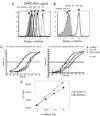A CD1d-dependent antagonist inhibits the activation of invariant NKT cells and prevents development of allergen-induced airway hyperreactivity
- PMID: 20083656
- PMCID: PMC2845715
- DOI: 10.4049/jimmunol.0901208
A CD1d-dependent antagonist inhibits the activation of invariant NKT cells and prevents development of allergen-induced airway hyperreactivity
Abstract
The prevalence of asthma continues to increase in westernized countries, and optimal treatment remains a significant therapeutic challenge. Recently, CD1d-restricted invariant NKT (iNKT) cells were found to play a critical role in the induction of airway hyperreactivity (AHR) in animal models and are associated with asthma in humans. To test whether iNKT cell-targeted therapy could be used to treat allergen-induced airway disease, mice were sensitized with OVA and treated with di-palmitoyl-phosphatidyl-ethanolamine polyethylene glycol (DPPE-PEG), a CD1d-binding lipid antagonist. A single dose of DPPE-PEG prevented the development of AHR and pulmonary infiltration of lymphocytes upon OVA challenge, but had no effect on the development of OVA-specific Th2 responses. In addition, DPPE-PEG completely prevented the development of AHR after administration of alpha-galactosylceramide (alpha-GalCer) intranasally. Furthermore, we demonstrate that DPPE-PEG acts as antagonist to alpha-GalCer and competes with alpha-GalCer for binding to CD1d. Finally, we show that DPPE-PEG completely inhibits the alpha-GalCer-induced phosphorylation of ERK tyrosine kinase in iNKT cells, suggesting that DPPE-PEG specifically blocks TCR signaling and thus activation of iNKT cells. Because iNKT cells play a critical role in the development of AHR, the inhibition of iNKT activation by DPPE-PEG suggests a novel approach to treat iNKT cell-mediated diseases such as asthma.
Figures






Similar articles
-
The development of airway hyperreactivity in T-bet-deficient mice requires CD1d-restricted NKT cells.J Immunol. 2009 Mar 1;182(5):3252-61. doi: 10.4049/jimmunol.0803339. J Immunol. 2009. PMID: 19234223
-
Plasticity of invariant NKT cell regulation of allergic airway disease is dependent on IFN-gamma production.J Immunol. 2010 Jul 1;185(1):253-62. doi: 10.4049/jimmunol.0902301. Epub 2010 Jun 4. J Immunol. 2010. PMID: 20525882
-
Activation of nonclassical CD1d-restricted NK T cells induces airway hyperreactivity in beta 2-microglobulin-deficient mice.J Immunol. 2008 Oct 1;181(7):4560-4569. doi: 10.4049/jimmunol.181.7.4560. J Immunol. 2008. PMID: 18802058 Free PMC article.
-
Tailored design of NKT-stimulatory glycolipids for polarization of immune responses.J Biomed Sci. 2017 Mar 23;24(1):22. doi: 10.1186/s12929-017-0325-0. J Biomed Sci. 2017. PMID: 28335781 Free PMC article. Review.
-
α-GalCer and iNKT Cell-Based Cancer Immunotherapy: Realizing the Therapeutic Potentials.Front Immunol. 2019 Jun 6;10:1126. doi: 10.3389/fimmu.2019.01126. eCollection 2019. Front Immunol. 2019. PMID: 31244823 Free PMC article. Review.
Cited by
-
Exosome-like nanoparticles from intestinal mucosal cells carry prostaglandin E2 and suppress activation of liver NKT cells.J Immunol. 2013 Apr 1;190(7):3579-89. doi: 10.4049/jimmunol.1203170. Epub 2013 Mar 6. J Immunol. 2013. PMID: 23467936 Free PMC article.
-
Repeated α-GalCer Administration Induces a Type 2 Cytokine-Biased iNKT Cell Response and Exacerbates Atopic Skin Inflammation in Vα14Tg NC/Nga Mice.Biomedicines. 2021 Nov 4;9(11):1619. doi: 10.3390/biomedicines9111619. Biomedicines. 2021. PMID: 34829848 Free PMC article.
-
Targeting iNKT cells for the treatment of sickle cell disease.Clin Immunol. 2011 Aug;140(2):177-83. doi: 10.1016/j.clim.2011.03.002. Epub 2011 Mar 22. Clin Immunol. 2011. PMID: 21429807 Free PMC article. Review.
-
Choline chloride attenuates the allergic airway disease by inhibiting the lysophosphatidylcholine induced response in mouse model.Curr Res Pharmacol Drug Discov. 2022 May 11;3:100109. doi: 10.1016/j.crphar.2022.100109. eCollection 2022. Curr Res Pharmacol Drug Discov. 2022. PMID: 35707627 Free PMC article.
-
Cytotoxic lymphocytes and atherosclerosis: significance, mechanisms and therapeutic challenges.Br J Pharmacol. 2017 Nov;174(22):3956-3972. doi: 10.1111/bph.13845. Epub 2017 Jun 13. Br J Pharmacol. 2017. PMID: 28471481 Free PMC article. Review.
References
-
- Centers for Disease Control and Prevention (CDC) Forecasted state-specific estimates of self-reported asthma prevalence—United States, 1998. MMWR Morb. Mortal. Wkly. Rep. 1998;47:1022–1025. - PubMed
-
- Wills-Karp M. Immunologic basis of antigen-induced airway hyperresponsiveness. Annu. Rev. Immunol. 1999;17:255–281. - PubMed
-
- Robinson DS, Hamid Q, Ying S, Tsicopoulos A, Barkans J, Bentley AM, Corrigan C, Durham SR, Kay AB. Predominant TH2-like bronchoalveolar T-lymphocyte population in atopic asthma. N. Engl. J. Med. 1992;326:298–304. - PubMed
-
- Wills-Karp M, Luyimbazi J, Xu X, Schofield B, Neben TY, Karp CL, Donaldson DD. Interleukin-13: central mediator of allergic asthma. Science. 1998;282:2258–2261. - PubMed
Publication types
MeSH terms
Substances
Grants and funding
LinkOut - more resources
Full Text Sources
Other Literature Sources
Miscellaneous

